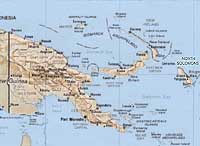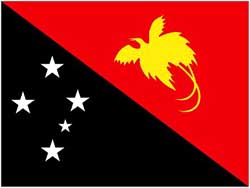-
-
- Papua New Guinea Map
|
-
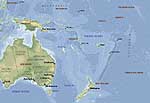
-
- Map of the Pacific
|
|
|
- latest picture: August 27, 2010
|
-
- "Are we in fact a bit mad in undertaking this task", as a friend of ours puts
it? Because precisely on the day of our departure to Papua New Guinea (simply called PNG)
we receive another serious warning regarding the security situation. This time from our
Ambassador Daniel Walker – on post in Australia and
therefore also responsible for PNG – who we had the honor to meet with his spouse on
July 14th, 2006, in the Sultanate of Brunei at a dinner with
the small Swiss community there. This message, however, is not anymore able to deter us
from the “last remaining frontier of the world” where tribal fights in the
Highlands are still as common as they were in the past. Too long and too hard we have been
working on our car entry permit during the past months, and too big is now our longing for
this adventure. At 10.30pm on July 26th, 2010, we are irreversibly on our way: We board in
Singapore the Air Niugini plane and fly towards the Eastern
part of the world’s second largest island (after Greenland): Papua New Guinea –
situated 100 miles North of Australia, an island which land is
shared in the Eastern side by the independent state of Papua New Guinea and the Indonesian
province of Papua in the West.
-
- During our six hours long night flight with an old, however overhauled and completely
full aircraft to the capital Port Moresby, inevitably some doubts are creeping through our
heads: Will the aged 767 make it safely to our new destination? Is the country really as
bad as its reputation, pointed out in most travel advisories? Will the ship from Jakarta/Indonesia with our container on board suffer further delays?
Will the release of our LandCruiser at Lae’s port work out smoothly? It largely
depends on the two last conditions, if we will make it in time to the famous Mount Hagen Sing Sing starting August 13th, – a show
similar to the Goroka Show – where 80 different ethnic
groups have a gathering to display their dances, traditionally dressed-up and decoratively
painted. Mount Hagen lies in the Western Highlands, a 275 miles drive from Lae. It dawns
and the rays of the rising sun are catching beautifully the puffy white clouds when
shortly after 6am the aircraft is preparing to land in the capital. No matter in which
direction we look – the landscape under the sunny sky is dry and yellowish like the African steppes – not rich green as we expected PNG to be
after the rainy season that ended end of May.
|
-
-
-
-

|
-
-
-
-

|
-
-
-
-
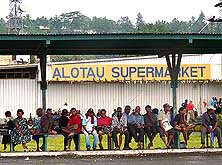
|
- 01
Brightly painted boats line the
- picturesque harbor shore of Alotau
- in the Milne Bay Province, situated
- at the Southeastern shore of the
- island of New Guinea
|
- 02
The Australian War Memorial to
- commemorate the Battle in Alotau in
- the Milne Bay, which the Australians
- fought with the help of the locals
- against the Japanese in World War II
|
- 03
It is always busy around
- Alotau’s supermarket. It’s also
- the place to exchange gossip
|
-
- While queuing up in one of the slowly moving waiting lines to the immigration desk, our
eyes are fixed on the huge exotic wall paintings in the reception hall: Characteristic
faces of different ethnic groups are peeking out of a jungle scene. They look friendly and
peacefully and chase away our worries, if we were possibly playing Russian roulette in
PNG. When the immigration and customs officers – we even can keep our (declared)
cheese – greet us with a smile, we immediately like this people with their curly
black hair and dark faces and their expression of friendliness. We drop our last doubts
and are looking forward to explore their special country. First of all, we withdraw Kina
– the local currency – at the ATM of the ANZ Bank at the airport and are glad
that we can cash twice K 2’000 (= US$ 715). Then we buy a new sim card from Digicel,
browse through the beautiful picture books laid out in the tourist office and drink our
first cup of highland coffee until it is time to board our connection flight – a
noisy two engine propeller aircraft of PNG Airlines – to Alotau on the Southeastern
tip.
|
-
-
-
-
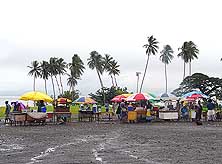
|
-
-
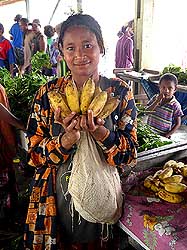
|
-
-
-
-
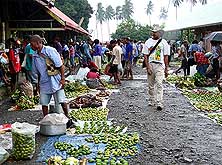
|
- 04
The market stalls opposite the
- supermarket at the palm-fringed sea
- shore with the colorful umbrellas that
- protect the sellers against sun and
- rain add to the charming village image
|
- 05
The young fruit vendor in
- Alotau’s fruit and vegetable market
- holds the bunch of banana
- while Liliana grabs 1 Kina
- (=US$ 0.40) out of her pocket
|
- 06
A big part of the produce sold in
- the open Alotau market is betel nut.
- There are whole lines of them lied out
- on the ground. Chewing these stimulating
- nuts is a part of PNG’s culture
|
-
- No roads are leading there. Therefore it is an ideal place to spend our time until the
arrival of our car. Apparently it left Indonesia only today
and the vessel is still making two stops on its way to Lae. It is raining heavily, when we
land at the small tropical airport of Alotau and hop into the waiting van of the Napatana
Lodge that we booked via internet. The palm oil plantations and the grass land we pass are
soaked in water from the loads that the heavy clouds have discharged apparently
uninterruptedly since weeks. Our driver tells us that they have not seen any ray of sun
for a very long time. Though we knew that Alotau – like also Lae – has the
opposite climate than the rest of PNG where in May the dry season started, we didn’t
take it seriously enough due to the climate change everywhere! Well, we indeed are now
surrounded by lush green and a rainforest living up to its name – actually more than
we would have liked! Our room in the Napatana Lodge is in the “Flashpackers”
section, i.e. it is one of the five budget rooms with attached bathroom, fridge and a
common veranda. “Budget” means Kina 176 per night (= US$ 63). Accommodation is
extremely expensive in PNG.
|
-
-
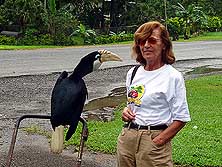
|
-
-
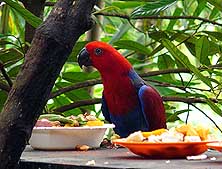
|
-
-

|
- 07
The tame hornbill is one of
- the two birds belonging to the small
- sanctuary of the Napatana-Lodge
- in Alotau. It iscurious and likes to
- be close to people;its favorite
- place being the bar …..
|
- 08
..... its feathered neighbor, the
- parrot, steels pieces of papaya
- from the hornbill’s food bowl
|
- 09
Emil is admiring one of the giant
- clams (Tridacninae) that adorn
- the well kept garden of Alotau’s
- Napatana-Lodge
|
-
- Slowly we realize that we did not only jump into a cultural adventure, but a financial
one too, because bush camping will be impossible, firstly due to security reasons and
secondly because – like in most of the Pacific Islands
– land is in private or tribal hands. Apart from this the culture of the people does
not allow that a visitor – especially a Westerner – sleeps in his own car. A
Westerner has the necessary money anyway to sleep in a decent hotel. Belonging to the
lodge, there is an enchanting small menagerie: We love watching the kangaroo hopping in
the grass, the colorful parrot steeling the papaya bits from the hornbill bowls, but
mostly we are amused by the two tame hornbills that are very human oriented. They like to
squeeze softly my fingers with their beak, or sit on the mowing machine when the gardener
is cutting the grass, or mingle with the guests in the bar. At the end of the day, the bar
on the first floor of the lodge made of bush materials is also our favorite spot. Gazing
to the beach with its illuminated stately palm trees, sipping a local beer and talking to
the locals is always enjoyable.
|
-
-
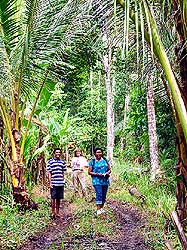
|
-
-
-
-

|
-
-
-
-
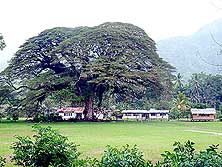
|
- 10
Through a wet forest path,
- we hike together with Grace and
- Toto from the “Ulumani - Treetops
- Rainforest Lodge” to the village of
- Wagawaga, situated across Milne
- Bay, 35 miles South of Alotau
|
- 11
A lonely outrigger canoe rests
- on the bank of the peaceful
- Wagawaga Bay
|
- 12
The modest school buildings
- of Wagawaga village sit on a
- privileged spot under a
- huge and shady tree
|
-
- During the night we hear the steady pouring of the rain, but also by day the heavy
showers don’t stop. There is hardly a dry moment. That’s the case on our first
day, on our second day and also on our third day. Finally we buy a huge umbrella in the
Alotau supermarket which turns out to be of little help. We get drenched from head to toe
when we walk the ten minutes into town. Again and again we are surprised how friendly
people are greeting us who are walking as we do. Small roadside stalls selling betel nuts
line the street all over. Chewing “buai” is part of daily life to almost
everyone. Mixed with a mustard stick and crushed coral lime makes it a mild stimulant
– similar to the qat leaves in Yemen. The red tinted
saliva that is produced by chewing is constantly spitted out, leaving red spots dotting
the streets. Betel nuts take up at least one third of the selling space at the market.
Then there is tobacco, carefully plaited into tresses, banana, vegetable and dried fish.
-
- PNG is scattered with relicts and memorials of World War II. One of it is the well
documented Australian War Memorial that we visit on our way to the harbor, when on the
fourth day the sun finally flickers through the clouds. It marks the spot at Milne Bay
where Australian and locals fought the bloody battle against the Japanese. The platform is taken by two souvenir vendors
displaying their carvings. But amazingly they make no attempt to sell us something. Quite
unusual! The harbor attracts us immediately. It is packed with brightly painted
one-man-canoes, island boats, passenger ships and stalls covered by colorful umbrellas.
Groups of people are sitting around, chatting and chewing betel nuts. Why do we not climb
up the hill to the hospital and enjoy a birds-eye-view? Little did we know by then that
soon we would see the hospital from inside! On our way back, a pick-up driver stops and
offers us a ride to the well stocked supermarket. We arrive just in time before at 5pm the
massive iron door closes for the night.
|
-
-
-
-
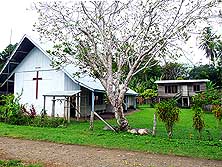
|
-
-
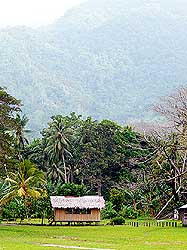
|
-
-
-
-
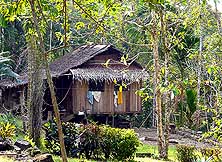
|
- 13
The church of Wagawaga
- matches the simplicity of the
- village houses
|
- 14
In harmony with the nature:
- Simple bush material house in
- Wagawaga in a tropical
- surrounding
|
- 15
In Warren Dipole’s village – the
- owner of the “Ulumani - Treetops
- Rainforest Lodge“ – life is peaceful.
- Surrounded by pure nature, his
- family would never ever want
- to move to the busy city
|
-
- “Are you looking for something?” a young man asks me next day in front of the
local vegetable market. I shake my head and tell him that I am just looking around. With a
smile he replies: “If you are looking for a man with a white beard, I just saw him
walking over to the supermarket!” Later, when we visit the Hotel International, a car
stops beside us. “Are you Liliana and Emil”, the lady asks us through the car
window? Slowly, it is getting weird. Where from does she know us? She introduces herself
as Ronah from the Tourist Office. From her boss in Port Moresby, Mr. Peter Vincent, she
got the order to take good care of us. Two days later – we are just having breakfast
on our verandah – she shows up with Warren, the owner of the Treetops Eco Lodge.
While drinking coffee, we are informed that a trip to the remote Treetop Eco Lodge and a
three-day stay there is offered by the Ministry of Tourism – what an unexpected
surprise!
-
- Joined by Grace who makes a year-long study about Eco Tourism for the University in PNG,
Warren drives us next day 35 miles with his LandCruiser to his lodge. All we see during
the first 16 miles along a good tarmac road are palm oil plantations. It is a bit
frustrating that after Malaysia and Indonesia now also PNG’s rainforest and sago palms are
replaced by more profitable palm oil trees. Luckily, as soon as we branch off to an earth
track, we find ourselves surrounded by jungle. Modest homes made from bush material are
scattered in small clearings, sometimes only one, sometimes two, sometimes a cluster,
depending on the size of the clan. Five brown jungle rivers, carrying much water across
the road are a challenge. Luckily Warren knows how to tackle them. But there are times
when he also has to wait until the water level recedes, we are told. When we reach a
steep, grassy ascent, he engages 4x4 and the differential lock. Both are indispensable to
make it up to his lodge. There where the track ends we reach our destination: Our cottage
above the treetops.
|
-
-
-
-
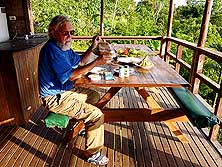
|
-
-
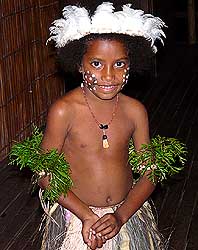
|
-
-
-
-
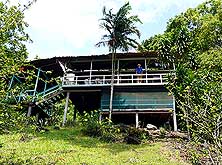
|
- 16
Emil enjoys his breakfast at the
- “Ulumani - Treetops Rainforest Lodge“
|
- 17
Stephanie, Warren’s seven
- year old niece, appears in
- traditional village outfit at the
- “Ulumani - Treetops Rainforest
- Lodge“ and entertains us with
- a cute dance performance.
- The big black dot on her
- cheeks symbolizes a spider net
|
- 18
Emil on the balcony of our
- cottage at the “Ulumani - Treetops
- Rainforest Lodge“, surrounded by
- trees and flowers. The chirping of
- birds is the only ‘sound’ in this
- oasis of peace
|
-
- The surrounding is overwhelming. Wherever we look, we see just forest and flowers and a
calm bay lures in the distance. The screeches of the parrots, the soft calls of unknown
birds and now and then the beat of the wings of a circling eagle are the only noises
besides the rustling of the wind. Shiny royal blue butterflies flutter past the balcony of
our comfortable cottage. For the next three days we soak up this closeness to nature like
a sponge and enjoy the stillness. Who knows when we will have such an opportunity again?
The forest path that we take in the afternoon to the village of Wagawaga is still muddy
from the continuous rain of the last days. Water puddles have to be crossed, and the hike
takes much longer than expected because we give the shortcut a miss. We are not in the
mood to walk barefoot through deep mud, and neither do we like to have our shoes filled
with dirty water and soil. Therefore it is already mid-afternoon when we reach the village
with its modest bush material houses built along the seashore. Dugout canoes are parked, a
war relict rises out of the water. Across the bay sits Alotau. At calm sea, the approach
by water is easier and faster than by road.
-
- The village looks sleepy. Apart of a young mother busy with her children at a washing
place and a few people walking along the street, nothing is moving. There is a school and
a modest church, but there is no medical care. The hospital is in the next village. At
least there is ONE car that in emergency can also be used for the transport of a patient.
Grace tells us further that in remote villages where there is not even a road, people have
to live without any medical service.”And what happens if somebody gets seriously
ill?” we ask. “Most people then have no chance of survival”, is her brutal
answer. A glance at the ghostly clouds developing at the nearby mountains warns us to
start our way back without delay. Soon also the mosquitoes will be active and having no
insect repellent with us, it is wise to hurry, because PNG is known for its widespread
malaria. Exhausted, but happy about the excursion, we reach “home” dry. It is
August 1st, the Swiss National Day. Memories from Apia in Samoa
come alive where we spent August 1st, 2009, among the Swiss community before we flew in
the same night via the Cook Islands to Tahiti.
|
-
-
-
-

|
-
-
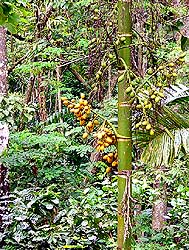
|
-
-
-
-
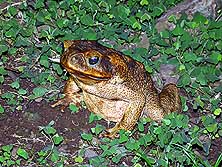
|
- Encounters with nature:
|
- 19
A butterfly sucking the
- nectar of a flower …..
|
- 20
..... Betel nuts that are chewed
- practically by everybody in PNG .....
|
- 21
….. a toad on its night excursion
|
-
- The second evening, while sitting on the porch of the main lodge enjoying a sundowner,
Stephanie, Warren’s 7 year old niece, appears in traditional outfit. She belongs to a
small group of village dancers, but performs alone for us tonight. She looks very pretty
in her headdress with white bird feathers, her collar made of precious red corals (in
earlier times a valued mean of payment) and her skirt of two-colored coconut fiber. A huge
black circle with white dots is painted on each of her cheeks, representing a spider net.
Charmingly, she first shows us the slow dance performed by villagers to farewell the men
when they embark to war. Then a livelier one for victory and safe return when they board
their war canoes und sail away.
|
-
-
-
-
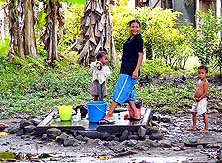
|
-
-
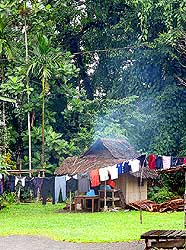
|
-
-
-
-
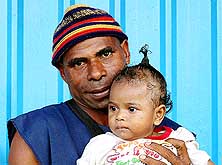
|
- 22
A young mother washing her
- clothes at the village’s “laundry”
- of Wagawaga
|
- 23
Smoke seeps through the
- grass roof of a bush kitchen.
- There is no chimney
|
- 24
The father in front of the super-
- market in Alotau is proud when we
- take a photograph of his baby girl
|
-
- The days are over much too fast at this lovely place surrounded by pure nature. The last
evening, all of a sudden, I get some serious stomach cramps. What am I hatching? After a
terrible night, Warren drives us back to the Napatana Lodge in Alotau. From the very first
moment, we sense the incredible difference: From the stillness we treasured so much, we
are back in the omnipresent noise. In the afternoon, I steadily feel weaker, the body
temperature rises and at 11pm I am shaken by violent shivers. The fever reaches almost
104°F. Luana from the lodge is sure: “It is malaria!” With her lodge bus I am
rushed to the hospital where I am finally given Chloroquine and Fansidar tablets –
they are free of charge. For the consultation, we pay Kina 10 (= US$ 4)! Now we regret
that we decided not to take any malaria prophylaxis, because especially here in wet Alotau
malaria tropica, which can be fatal, is raging. We are therefore confined to the hotel
room for the rest of our stay in Alotau and have unfortunately to give a miss to the
excursion to the East Cape, offered by the Ministry of Tourism.
|
-
-
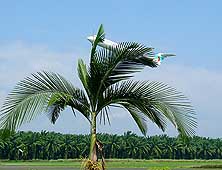
|
-
-
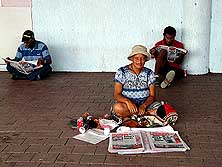
|
-
-
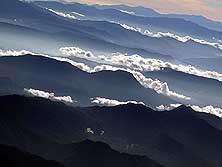
|
- 25
Air Niuguini with the logo of the
- bird of paradise on its tail takes off
- at the exotic Alotau airport
|
- 26
There is no newspaper kiosk
- at the airport of Port Moresby, the
- capital. A woman sells the daily
- papers on the floor outside
|
- 27
During our flight from Port
- Moresby to Mount Hagen in the
- Highlands, we get a glimpse of
- the inaccessibility of this region
|
-
- Is it the nourishing chicken soup that the lodge prepared for me – by the way with
Kina 28 (= US$ 10) the most expensive soup I ate in my whole life – or the
“new” malaria tablets on the Artesunate basis from Vietnam and China that we
bought in the village pharmacy? In any case, on Sunday I am on my feet again and able to
board the plane back to Port Moresby. In the capital, we booked for three nights a room
with shared bath room at the “Comfort Inn”, not too far from the airport.
Actually, it is meant to be a backpacker’s accommodation – but with a different
price structure. It costs Kina 305 (= around US$ 110)! No wonder that there are no
backpackers! Since oil and LPG gas were discovered in the Southern Highlands of PNG, the
prices went wild particularly in Port Moresby. Now even business people lodge in the
“Comfort Inn”.
|
-
-
-
-
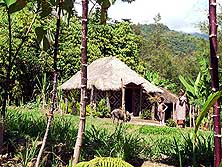
|
-
-
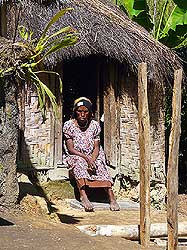
|
-
-
-
-
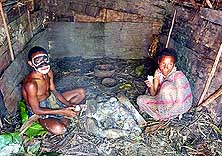
|
- 28
A scene like in Africa: Mother,
- son and a pig in front of a thatched
- hut in Nem, a tiny village on the
- outskirts of Mt. Hagen …..
|
- 29
..... the mother is resting at
- the entrance to her home with its
- woven walls made of pit-pit
- grass (miscanthus floridulus) …..
|
- 30
..... family members sit around
- a fire place in their “hut” and
- cook sweet potatoes, the main
- diet of the Highlanders
|
-
- In any case, we are the only white people, also when we walk around the nearby township
of Boroko to get a personal feeling about the security situation. The reels of barbed wire
on already high walls and the security guards in front of every bank, business and shop,
often with trained Rottweiler dogs on a leash, speak a clear language. However, our first
“excursion” at daylight goes well and we never feel in any kind of danger.
People are greeting us friendly. Also next day in downtown Port Moresby we have no
negative experiences so far. Therefore our security confidence grows for the visit of our
next “ill-famed” city – Mount Hagen, the provincial town of the Western
Highlands – unfortunately still without our LandCruiser that is yet sailing somewhere
on high sea between Indonesia and PNG.
|
-
-
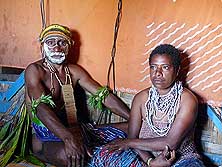
|
-
-
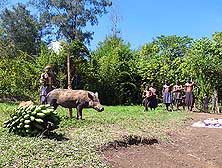
|
-
-
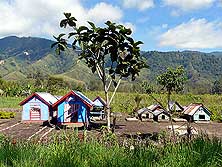
|
- 31
A traditionally dressed couple
- sits side by side. Occasionally, they
- rub their heads together. It shows
- the ceremony of courtship …..
|
- 32
..... does it come to an agreement,
- the bride price still has to be approved.
- Do the clan members of the man accept
- the deal the woman immediately leaves
- her clan and joins the one of her
- husband. This shows the ceremony
- of handing over the bride price
|
- 33
A little cemetery: The graves
- of the deceased have a roof to
- protect them from wind and weather
|
-
- The vessel is now delayed already by 16 days and is scheduled to arrive only on August
13th, at Lae’s harbor, that means after the famous Mount
Hagen Festival – the Cultural Show that was initialized 1961 to bring together
warring tribes and to create a peaceful atmosphere among them. Through all the years, this
event has been maintained, and today, it is one of the biggest tourist attractions in the Pacific. Of course, by no means we want to miss it. And
there is only one possibility left: To take the plane! We still manage to get two seats on
August 11th , to Mt. Hagen and another two seats six days later onwards to Lae, but are
less lucky with the hotel accommodation. Everything is booked out! What now? Mr. Peter
Vincent, CEO of the Tourist Promotion Authority, helps us out. A phone call with Bob
Bates, the owner of Trans Niugini Tours in Mt. Hagen, is enough to make us happy. He
offers us to stay at his staff house free of charge, which turns out to be a real
“bull’s-eye”.
|
-
-
-
-
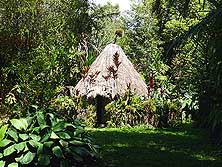
|
-
-

|
-
-
-
-
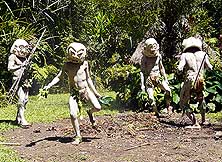
|
- 34
A bush hut in Pogla in the
- outskirts of Mt. Hagen, hidden
- in the luxurious tropical vegetation
|
- 35
This woman from Pogla
- with her bunch of shell necklaces
- and her skirt of leaves transfers
- us into another world.
- “Topless“ is normal here
|
- 36
“Mudmen” – warrior covered with
- grey mud and wearing a horrifying mask –
- approach the enemy that took their land.
- Believing to see ghosts, those run away terrified.
- A scene replayed in Pogla. The “original”
- mudmen originate from Asaro near Goroka
|
-
- Once more we therefore board a propeller aircraft of Airline PNG and fly with much
anticipation towards the highlands. By the way: Airlines PNG is the budget airline of
Papua New Guinea, if we can talk of “cheap” at all. The weather is wonderful as
is the hourly flight through rugged mountain scenery with its many dark ridges framed by
shiny white clouds. We are glad that it is a clear day because Mount Hagen does not have
an “instrument landing system”. It therefore needs an experienced pilot and one
well familiar with the region – most of them seem to be Australians. Shortly before
landing we fly still between mountain ridges and, as it seem to us, directly towards a
rising peak. And right after “just missing” said peak, we dive down to the
airstrip where we land a bit choppy. A Trans Niugini driver is waiting for us and brings
us to the city office 6 miles away, where the friendly team of Shirley from South Africa,
Pauline from Canada and Dwayne from Swaziland welcome us warmly.
|
-
-
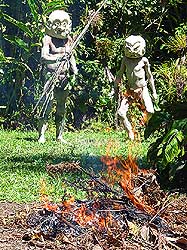
|
-
-
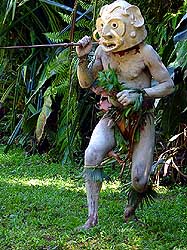
|
-
-
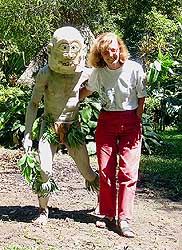
|
- 37
“Mudmen“, equipped with arrows,
- approach the camp fire of their enemy …..
|
- 38
..... who would not run away
- at this terrifying appearance .....
|
- 39
..... a “Mudman“
- seizes Liliana!
|
-
- Already two hours after our arrival we are sitting together with Azusa and Kazuto, a
Japanese couple in their forties traveling since three years with the goal of visiting all
the independent countries in the world, in a tour bus. The visit of three villages is on
the program. The first one is called Nem. Through a shady jungle garden, we arrive at a
single thatched hut. A small boy huddles in the grass between two pigs tied to poles while
his mother drags a heavy banana branch to the hut. In the interior, family members gather
around a small open fire, eating sweet potatoes – the main diet of the highlanders.
It represents a scene of daily life. In another hut we meet a ceremonial dressed couple
staging the courting rituals. They sit legs crossed side by side and occasionally rub
their faces fiercely together. Those courting sessions usually occurred in a long house.
If the couple came to terms, the bride price was discussed. It mostly consisted of pigs
– still valued today as a symbol of wealth – but also kina shells, cash and
food, such as banana and sugarcane bundles. Did the women’s clan members agree to the
offered bride price, the official handing over took place immediately. Thereupon the bride
left her clan and went to live from now on with the man’s family.
|
-
-
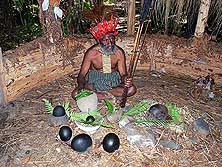
|
-
-
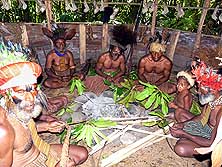
|
-
-
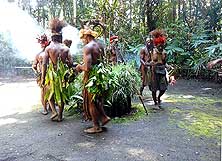
|
- 40
In the village of Tokua, the
- witch doctor is conjuring away the
- spirits. Despite of Christianity,
- animism still plays an important role
|
- 41
In Tokua, the „Moka“-Ceremony
- is put on stage for us. It is celebrated
- to solve problems and reconcile warring
- tribes and takes place around the fire in
- a house Tambaran, a spirit house …..
|
- 42
….. ending the
- “Moka”-Ceremony
|
-
- In Pogla, the second village on our tour, the legend of the “Asaro mudmen” is
performed – of the warriors who inventively covered themselves with grey mud and a
fearful huge mask – to chase away the enemy that occupied their land. The mask can
weigh up to 20 pounds. While the “original” mudmen are said to come from Asaro
near Goroka, there are today many “copied”
versions all over the highlands. The story goes as follows: Many years ago a farmer of a
small clan was working peacefully on his land. Suddenly, men from another bigger clan
appeared who claimed that this is their land. A serious fight broke out. The enemy won and
the defeated were expelled and fled into the mountains. Looking for revenge and a way to
recuperate their land, they had the inspiration to transform themselves into
“mudmen”. In this ghostly apparition, they took their enemy clan by surprise.
Those thought that the spirits of the dead returned and fled in terror. After that the
small clan returned happily to his land.
|
-
-
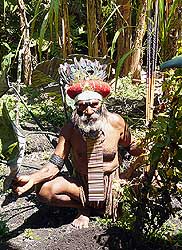
|
-
-
-
-
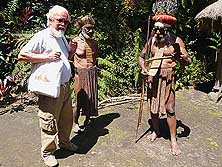
|
-
-
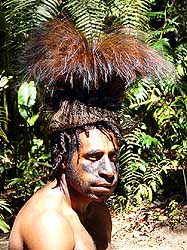
|
- 43
The charismatic “Bigman“, the
- village chief, poses for a picture. He
- wears a long band with bamboo rods
- around his neck. Each one represents
- ten pigs that he had given away
|
- 44
The village chief and a village
- elder in a conversation with Emil
|
- 45
One of the performers in Tokua wears
- an impressive headdress with Cassowary
- feathers (it belongs to the Emu family)
|
-
- In Tokua, the third village, surrounded by a beautiful orchid garden, we meet the
charismatic “bigman” – the village chief – in his full traditional
outfit. He wears a long necklace with bamboo rods tightly strung together. Each one
represents ten pigs which he gave away or slaughtered in one of the most important
celebrations – the “Moka” ceremony (pig exchange ceremony). In the highland
society, status is earned by giving things away. It raises its influence, and showing its
wealth is therefore of great importance. “Moka” is celebrated to solve problems
and reconcile warring tribes or estranged parties and takes place around a fire in a
Tambaran, a “spirit house”. This ceremony was staged for us, giving us thus a
deeper insight into the traditions of this country that despite of Christianization is
still connected with the ghostly world.
|
-
-
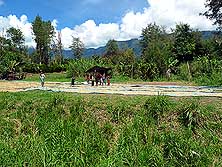
|
-
-

|
-
-
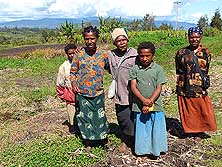
|
- 46
PNG is a coffee growing country.
- When the beans are red, they are picked
- and laid out to dry for five days in the sun
|
- 47
A modest hut in the Western
- Highlands near Mount Hagen –
- a typical Highlands sight
|
- 48
The “Highlanders” flock from all
- directions when they spot a Westerner. They
- are very curious, but also very interested
|
-
- In the evening, we are invited by the Trans Niugini Team to a rich barbecue together
with the Japanese couple who landed here by Coach Surfing with Dwayne as their host. There
is a huge fish, cooked in aluminum foil on the open fire, rice, salads, ice cream,
chocolate, wine and beer. Despite of our habit to skip dinner, we cannot resist and enjoy
the offered food. Also Bob, the owner, joins us and we have thus the opportunity to
express our thanks for the accommodation, the tour and all the courtesies. By then we do
not know yet that the premises of Trans Niugini Tours will become once more our
“home” for two weeks and that it opens the doors for new friends.
|
-
|
- The days from August 12th, to 16th, 2010, are on the following page: Mount Hagen Cultural Show
|
-
-
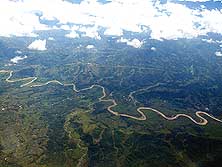
|
-
-
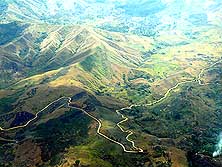
|
-
-
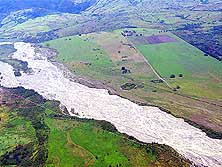
|
- 49
The clear view on our flight from
- Mount Hagen in the highlands to Lae
- on the coast show us the remoteness
- and ruggedness of the region …..
|
- 50
..... there is not much sign of
- life, only a track zigzagging
- through the mountains …..
|
- 51
….. down in the valley, the
- Markham River flows
- through fertile land
|
-
- Our heads are still cramped with all the experiences when on August 17th, we leave
behind the rolling hills of the highlands, the coffee and tea plantations and the
comfortable climate of Mount Hagen, situated at an altitude of 5’500ft., and fly to
the tropical heat of the rainy port town of Lae. Our LandCruiser, stuffed in its 19th
container, is already waiting for us. In the Lutheran Guesthouse we are given a spacey
room with five beds just for the two of us. Surrounded by a tropical garden and 660ft.
away from the road, it’s an oasis of peace in this dusty, unattractive and criminal
town with its badly potholed streets. Next day we are sitting in the office of our agent
East West Transport and are really shocked when Mr. Dotty presents us the bill for port
fees, quarantine, agent fees, etc. We have to pay US$ 850 – after New Caledonia the second most expensive port yet. (Remark: The
PNG’s following country – the Philippines –
exceeded everything in this respect!). But we perfectly know: This is how it is and there
is nothing to argue about if we like to visit the country.
|
-
-
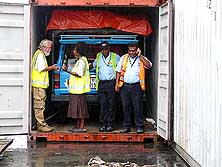
|
-
-
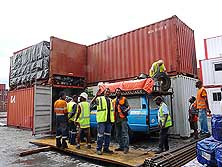
|
-
-
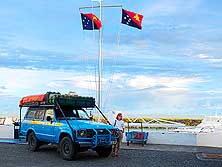
|
- 52
In the port of Lae: Emil in a
- discussion with Joanne, the customs
- officer, while Dotty and Alfred of
- “East-West Transport”
- are assisting us …..
|
- 53
….. finally our LandCruiser is
- out of its 19th cage. Emil is putting
- away our spare wheel on the roof rack.
- It’s laid before the right front wheel
- before the car gets lashed down …..
|
- 54
..... We made it! Our LandCruiser
- is parked at the Lae Yacht-Club while
- we celebrate the entry into our l67th
- country with a big burger
- and an ice cold beer
|
-
- After we settled the bill, we are driven to our container, joined by Joanne, a young
lady customs officer. When we watch the breaking of the seal, Emil suddenly hesitates. He
looks at the number twice and knows immediately that it’s not the original one from Indonesia. Additionally our personal padlock is missing. There
is no doubt: The container has been opened somewhere along the route. We later figured out
that it happened in Jakarta due to some customs reasons. When finally the container doors
open, we look inside skeptically. But besides our broken padlock lying on the floor, at
first sight we cannot see anything suspicious and are therefore just happy to be reunited
with our “best friend” after six weeks separation. In this respect we are just
very careful because it could happen that “our” container is reopened and used
for other, may be dubious additional transports after our loading. It starts to rain. To
open the side doors for inspection is impossible in this narrow box. But a short glimpse
into the rear of our car is enough for Joanne to realize that in our case she is not
competent enough to make a decision. She has never seen such a car with such content
before and wants to talk first to her superior. Apologizing she admits however, that her
boss is out of office at the moment. That was it then for today – maybe tomorrow?!
-
- At lunch time next day, Dotty comes up with the good news that the customs release is
signed and at the same time he tells us that he will be absent in the afternoon due to an
emergency. He delegates Alfred, his assistant, to take care of us. Today, we have to deal
with the quarantine. Alfred fetches the lady inspector. Yes, it is again a lady, and the
four of us drive once more into the port to our container. And again it starts to rain and
again the rain is on our side with the result that after taking a quick look of our really
thoroughly washed car in Jakarta – still in its box – the inspector is happy.
What we carry inside is of no interest to her. Important is that we pay the Kina 135
inspection fee (= US$ 48). Then finally, our LandCruiser is allowed to leave its cage, but
we cannot drive away yet as merchandise is piled up all around. In no time, we are
surrounded by port workers. Their enthusiasm is big when we add the Papua New Guinea
sticker to our country list at the car sides. Then it is coffee break and everything gets
to a still stand. Alfred from the agency does not want to wait any longer. He gives us the
papers we have to hand over at the port exit and gone he is! Is there any reason for his
sudden hurry?
-
- It seems to be the case because at the port exit problems start to develop regarding our
car’s content, with no one to assist us: Dotty is absent and his cellular phone is
switched off. And Alfred ended in smoke. Did the two have a presentiment? Do we eventually
have to bribe? While still puzzling what to do, there is a sudden change of mind. The
barrier is lifted and we drive out of the port. We made it, what a joy! How officially we
are in the country however, the future will show because we have no permit whatsoever in
our hands allowing us to drive on PNG’s roads with our left-hand driven vehicle and
our foreign license plates. What happens if we are stopped by the police and asked for? It
would not be our first case. We experienced it in Japan
with a positive outcome (because the Japanese do not look for problems), and just recently
also in Tonga, where the police wanted to confiscate our
LandCruiser and we were allowed only after a two weeks circulation ban to drive again.
Let’s see how we will be able to save our neck here in PNG!
|
-
-
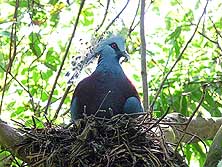
|
-
-
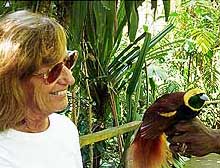
|
-
-
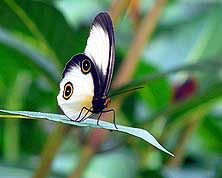
|
- Visit of the “Rainforest Habitat“, 6miles outside of Lae – an area of
about 1 sq mile of reconstructed rainforest
|
- 55
A Victoria Crowned Pigeon
- (Goura victoria) – weighing up to
- 5.5 lb – nesting on a tree …..
|
- 56
..... Liliana admires the beautiful
- bird of paradise (Raggiana Bird),
- the symbol of PNG …..
|
- 57
..... and one of the many
- white butterflies fluttering around
|
-
- The first drive in our new country is a short one: From the port to the Yacht Club where
we celebrate with a couple of draft beers and a rich beef burger topped with ham, cheese,
salad, tomatoes and beetroot the successful entry into our 167th country. We gaze out to
the sea, enjoy the cool sea breeze and are completely happy! Suddenly a guy is coming
straight to our table and presents us his business card. He turns out to be a journalist
from the “National” newspaper. “Who is sending you”, we ask him and
are really surprised that it is the customs that we left only a short time ago. Next day,
when we drive through the badly potholed streets of Lae, the locals wave at us already
enthusiastically, busses and trucks honk. The telephone rings: It is Joanne from the
customs asking us about our well-being. Everybody seems to have read about our arrival.
What a good feeling – what lovely people!
-
- In Lae, also called “the pothole city” – a well deserved name! – we
get stuck a bit longer than expected. The reason is for a change our good old LandCruiser.
It has hardly left the container, when without warning the engine dies at full speed in
the middle of the city, and not only once! Surprisingly, after a few minutes, we can
re-start again. Nevertheless: The prospect to get stuck somewhere in the nowhere in a
country where hold-ups by rascals (road bandits) occur frequently is not a good feeling.
Not too long ago, we faced the same problem in Sumatra.
There we replaced the contacts (points) and the condenser and since then it did not happen
again. What might be the reason this time? Without delay we need to get to the heart of
the trouble. At the parking lot of the Lutheran Guesthouse we work ourselves for hours
through the incredible mess of cables and wires beneath the dashboard and after a long and
painstaking search we finally find the cause: A loose and heat affected contact in the
main power cable that runs to the amp-meter. To make our search more difficult, it was
well wrapped with duct tape.
-
- After the repair, we make the 6 miles test drive to the “Rainforest Habitat”
– a reconstruction of a natural rainforest with a small lake and tropical plants,
birds in a huge aviary and an attached mini-zoo. At 9.20am we are already at the entrance,
having overlooked that the gate opens only at 10am. But we are in PNG – in the
country of the unexpected. As soon as we settle down under a shady tree prepared to wait,
two park employees come along bright-eyed. “We just opened the door for you, you may
drive in”. It is another example of great helpfulness of this welcoming people who
have a devastating reputation in the world that they do not deserve.
|
-
-
-
-
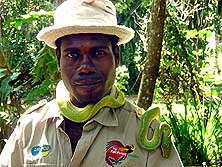
|
-
-

|
-
-
-
-
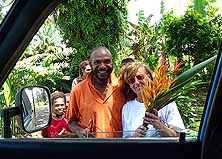
|
- 58
A park ranger shows us a tame
- green tree python (Morelia viridis) …..
|
- 59
….. a cute tree kangaroo
- (Dendrolagus) with a two
- months old baby in its poach
|
- 60
A lovely experience: Outside the
- “Rainforest Habitat”, a local stops us and
- joyfully presents us with an exotic bouquet of
- flowers that he picked in his garden for us
|
-
- Much time we spend at the covered bird house – it recalls the Edward Youde Park in Hong Kong – gazing into the high dark treetop to locate
its residents. It needs a sharp eye to spot them in the dense foliage, except for the
colorful parrots that draw their attention already with their rasping calls. Much easier
to see are the proud Crowned Victoria Pigeon that flounce around fearlessly and flaunt
their beautiful feathered comb. It is pure luck that we are also able to admire from very
close one exemplar of the fascinating birds of paradise. Caught in the highlands it was
sold this morning to the park, for how much we do not know. It is just feeding time. We
hardly believe our eyes when the warden distributes the food bowls: Bits of pawpaw and
other fruits are decoratively arranged alternatively in layers with white rice, and in the
middle sticks a red ginger flower – according to the motto: “You eat with your
eyes first!”. At the attached mini-zoo live cassowaries (a kind of Emu), birds of
prey, tree kangaroos, opossum and “Argo” a 30-year inactive saltwater crocodile
in a too small pond. Saltwater crocodiles can grow up to 23ft. and weigh 2’200
pounds.
-
- On our way back to the city, a car stops. Its driver steps out and walks straight away
towards us. He greets us with a heartfelt “Welcome to PNG” and shakes
enthusiastically our hands. Shortly after, a man stands on the side of the road and waves
gladly. Spontaneously we stop. He asks us to wait for a second and runs off –
apparently to his garden. Because shortly afterwards he returns with a bouquet of exotic
flowers. He especially picked them for us and hands them over to me. In addition, he
decorates our LandCruiser with four beautiful Heliconia flowers. What a heart-warming
gesture! Again and again we are mesmerized of the wonderful kindness of the people of PNG.
|
-
- More websites from Papua New Guinea:
-
-
|
- Articles in newspapers about us in Papua New Guinea:
- Article: "26-year journey
around the world", Daily Newspaper "The National"
- August 20, 2010
- Article: "Travelling
the world none-stop for 26 years", Daily Newspaper "The
National" - October 21, 2010
|
![]()
